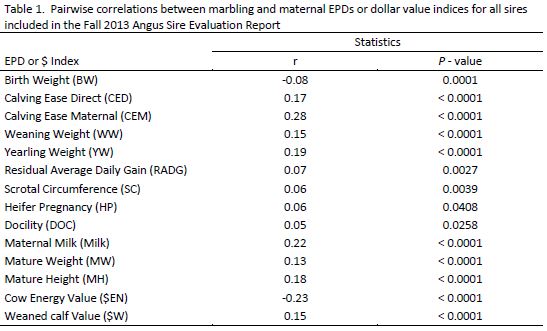



Beef Marbling: Maternal Cows Work
It may be easier to explain away why you don’t have marbling in the herd than it is to get it, writes Miranda Reiman for Certified Angus Beef Brand.Some say that’s the origin of the popular “urban legend” in the Angus breed: high marbling potential is for “terminal” cattle, because they don’t make good mamas. You can’t have both in the same herd.
“People have created this theory mainly because they haven’t ever selected for carcass traits, so they try to characterize their herd as ‘maternal’,” says Bill Bowman, longtime operations and genetics executive at the American Angus Association.
A new research paper, “Selection for Marbling and the Impact on Maternal Traits,” by Virginia Tech Extension animal scientist Scott Greiner and graduate student Jason Smith, explores the topic and may be viewed at http://www.cabpartners.com/news/research.php
“Marbling has a very small, if not insignificant relationship, with most of the traits that we associate with cowherd productivity,” Mr Greiner says (see Table 1). “You can have terminal traits and maternal traits, and they can coexist.”
The first step to building a productive cow is to get her bred and bred early. Scrotal circumference is considered an indicator of fertility, both in bulls and their daughters.
“Early on, there were a couple of fairly high marbling bulls that also happened to be low scrotal circumference bulls, and automatically there was this association that marbling and scrotal circumference had this big negative relationship,” Mr Bowman says, “but that is not the case.”
Both small-scale studies and actual analysis of the expected progeny differences (EPDs) for marbling and scrotal circumference found no association between the two traits.
“In the Angus breed we don’t have a ‘females reaching puberty’ problem at all,” Mr Bowman says, but the paper also confirms that a marbling focus will not impact age of puberty.
“Age at first calving” is often used to determine if a female will get pregnant during a normal breeding season and studies show differing results. One indicated no relationship and another said an increase in a full unit of marbling would extend age at first calving by 10 days. The practical application of the latter leaves little need for concern.
“A breeder that makes a 0.25 unit improvement in marbling EPD would be expected to increase age at first calving by less than three days,” the authors state.
There is no correlation between marbling and heifer pregnancy in the Angus database.
“Angus sires are highly sought after amongst commercial producers due to their ability to excel at calving ease while they maintain or improve carcass traits when compared to a number of other breeds and their composites,” the paper says.
The research is limited, but what there is highlights possible positive impacts, such as increased marbling in tandem with calf survival, lower birth weight and better calving ease.
The Association’s data shows there is a positive correlation between marbling and maternal milk EPDs at .22.
“This is always important, whether you’re selecting for marbling or not: keep milk production at a level that’s appropriate for your environment and your management,” Mr Greiner says.
The paper notes, “Opportunity currently exists within the Angus sire population to select for marbling while divergently selecting for maternal milk.”
The scientists found no evidence of increased calving interval or reduced stayability among high-marbling populations.
Seedstock producer Lee Leachman, Wellington, Colo., says, “We calculate a calving interval EPD and it is not correlated to marbling in our database.”
He also wondered about the impact of popularity in AI sire selection, since that is bound to be “influenced by the trends and fads of the day. The use of outlier, high dollar-beef ($B) bulls has become less popular because of the perception that those cattle might be less functional.”
Indeed, Bowman says the average marbling EPD of the 25 top-use AI sires had dropped. But the recent white paper showed all of the trait correlations maintained the same trends when high-use and high-accuracy bulls were compared to the Table 1 data for all Angus sires.
Research on mature cow size and efficiency is less clear. High-marbling cows may tend to be larger and slightly less efficient. The cow energy dollar-value index ($EN) has a minor negative correlation with marbling at -.23, but the marbling EPD is positively correlated with residual average daily gain (RADG) and the weaned calf ($W) index, “suggesting a favorable relationship between marbling potential and both pre-weaning value and post-weaning gain efficiency,” the paper says.
Using EPDs and indexes to match cattle to environment is key.
“The tools are there; you just have to use them,” Mr Bowman says. “The mature size-type components are totally underused.”
Mr Greiner says it’s important to note that environment is at work, too. Breeding for maternal traits takes much longer to see marked improvements since they’re lowly heritable, he says.
“Take a trait like fertility…we do know there is a genetic component, unquestionably,” Mr Greiner says.
“It’s just that the environmental factors override it so much that genetic selection becomes more difficult for the simple fact that identifying differences becomes more difficult.”
Dick Beck, Three Trees Ranch, Sharpsburg, Ga., says that’s why it is so rewarding to focus on both sides at the same time.
“Of course we should keep working on the cowherd, but why would you walk away from making progress on a trait that’s easily improved?” he wonders.
“To say I’m going to improve 90-day conception rate by 5 per cent , that is a tough, tough goal,” says Mr Beck. “Saying I’m going to improve the quality grade of my next calves by 5 per cent, I can do that in my sleep, with the right genetics. And it doesn’t take away from my efforts to improve on those tough goals.”




